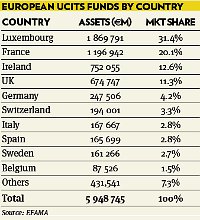Ucits products continue to raise the bar
Ucits has proved to be a huge success, but does the arrival of so-called ‘Newcits’ funds risk damaging the directive’s reputation?
Quotas forcing thousands of fish, which happened to be in the wrong place at the wrong time, to be destroyed and dumped out at sea rank amongst the European Union’s worst policy disasters.
But feeding the public’s demand for regulated, safety-stamped financial products with the Ucits directive is undoubtedly one of the biggest successes for the on-going European project. The 1985 directive in Ucits (Undertakings for Collective Investments in Transferable Securities) was initially introduced to make sure standardised investment products manufactured and developed in one EU member state could be readily distributed into neighbouring countries. The third instalment, introduced in 2002, hugely broadened the powers of investment that could be used to include derivatives, which totally transformed the product sets available to mass market investors, introducing a range of sophisticated techniques previously available only to a small coterie of high powered institutions.
A fourth update will be introduced in 2012, concentrating on informing and empowering the consumer, with some easier to follow simplified introductory documents.
“The main achievement of Ucits funds has been to focus on what products should be doing to properly protect themselves from risks,” suggests Charles Fox, a solicitor and regulatory specialist at Laven Legal Services in London. “Ucits may have been designed to make investments more democratically available, all across Europe, but one of the results is that it has led to higher standards of product design. There is no other product so highly regulated within the financial industry.”
Products, particularly those regulated by the groundbreaking Ucits III directive, are generally more expensive to build and run than similar investment strategies housed under offshore wrappers in less regulated jurisdictions, says Mr Fox. “But they are seen by investors as having a higher standard of operation and regulatory focus to protect them from potential blow-ups.”
Immediately after Ucits III was enacted, Luxembourg’s regulators were challenged by a spate of applications from predominantly fixed income managers, keen to utilise newly permissible option and currency strategies. Although some of the wilder proposals were dismissed, fund managers such as Pimco and Goldman Sachs Asset Management received approval for new and innovative product sets. These radically transformed fixed income from a soporific buy-and-hold asset class to a fast-trading alpha-grabbing sector of the industry.
“Fixed income managers picked it up and ran with it first. Equity managers were slower to take advantage,” confirms Kate Hollis, lead analyst at Standard & Poor’s Fund Services. “Every fixed income fund out there uses a hedge fund lite strategy. Ucits III was not set up for fixed income, but fixed income managers needed more flexibility. Yield curve trading is much easier to do using derivatives.”
The asset management arm of Goldman Sachs, one of the pioneers of heavy promotion of Luxembourg-registered Ucits-linked product ranges for distribution across Europe, has developed a range of absolute return-oriented strategies in Ucits. This includes macro fixed income strategies, active currency, equity long-short, commodity strategies and a fund of Ucits absolute return funds.
More recently there has been a second wave of Ucits under the so-called ‘Newcits’ banner, where hedge fund strategies are being adapted for onshore customers and wrapped in a Ucits compliant structure.
But manufacturing companies as well as distributors are divided on how important these funds will be in investors’ portfolios. “The ‘Newcits’ banner isn't one we think is particularly applicable considering there is nothing new about being able to develop absolute return oriented strategies,” says Shoqat Bunglawala, head of international product strategy and development at Goldman Sachs Asset Management.
“Much of this has been possible since the introduction of Ucits III in 2002 whilst Ucits hedge fund index products have been possible since the CESR guidance of 2007.”
The vast bulk of existing Ucits and the majority of new products being devised are firmly in the traditional asset class bracket, says Mr Bunglawala, with a focus on long only equity, fixed income, balanced and money market asset classes.
There is also continued development of absolute return strategies in Ucits, as investors seek to diversify their portfolios. Along with some other major investment houses such as Credit Suisse, Goldman has for several years been busy building its reputation in running multi-asset global allocation strategies, for investors seeking to outsource the overall management of their assets.
GSAM is also able to offer products with a focus on growth and emerging markets in both the equity and the fixed income space, confirms Mr Bunglawala. “In some cases, more recently, we have been able to blend a mixture of equity and fixed income instruments.”
But not everyone shares GSAM’s vision. Some commentators talk about inappropriate demeaning of Ucits powers and Laven’s Mr Fox refers to “in the worst case scenario, a shoe-horning of hedge fund strategies into the wrapper of a Ucits product”. Sub-categories of more complex alternative products are being created in the name of what should be harmonised product templates, accessible to retail investors, he says. “This is not the tenet or the spirit of what Ucits was all about.”
Laven’s lawyers talk about “naughty ones” trying to get around the rules, with European regulators aware of potential abuses and expected to clampdown soon.
Debate rages, with consultants such as Standard & Poor’s Ms Hollis convinced that Ucits III does indeed provide an appropriate wrapper for alternative investments including equity long-short, currency and macro funds.
“When it comes to commodity funds, you need to be more careful and it is with illiquid strategies where the real problems start,” she says, casting doubts over the suitability of these regulations to govern mortgage-arbitrage strategies and others requiring shorting of securities. Her fear is that Ucits V may turn out to be a “game changer” and possibly remove some of the freedoms conferred under Ucits III, following exasperation from the regulators about just how far some fund groups are prepared to push the rules.
Splitting Ucits into ‘complex’ and ‘non complex’ boxes remains a very “delicate subject” in the industry, according to Jean Baptiste de Franssu, outgoing president of Efama, the European Fund and Asset Management Association, and until recently European chief executive of Invesco.
“The regulatory uncertainty and Alternative Investment Fund Managers’ Directive led to a number of more sophisticated products taking advantage of the European passport under Ucits,” he said during a valedictory appearance at the recent Fund Forum conference in Monaco. “But the Newcits concept will start fading away. The idea of complex and non-complex labels will simply become a marketing gimmick.”
Ucits III was never designed for hedge funds, which should soon migrate to their rightful place, being regulated under AIFMD, believes Mr de Frannssu, with numbers of so-called Newcits already in decline. But it can be the very strength of the Ucits regulations and perceived quality of the product structure which leads hedge funds to want to squeeze themselves through the doorway.
“The AIFMD is potentially a good idea, but it is a woolly mammoth, before it is ever born and now there are even more bizarre proposals coming out of Brussels,” says Julie Paterson, director of the UK’s Investment Management Association. “That is why so many funds have tried to jump under the Ucits III umbrella. It is a proven brand, it has a passport and has seen a lot of stretching because people wanted to be represented by this brand.”
Instead of allowing Ucits to be abused and divided, simple, harmonised Ucits mutual funds should continue declaring war on the real enemy – structured products – believes Mr de Franssu. “Structured products are opaque and highly charged. Ucits mutual funds are the most advanced products of all in terms of transparency.”
A very good example of this transparency, he says, is the forthcoming requirement for fund groups to present KIIDs (Key Investor Information Documents) to end investors. These are sought to replace the current Simplified Prospectus with a harmonised two-page template that will be used across the industry.
GSAM expects to begin production of the KIIDs required under Ucits IV during the transitional period ahead of July 2012. “This has resulted in increased costs and with the requirement of a KIID per every share class of a fund and in multiple languages, the sheer volume of documents will be immense,” says Mr Bunglawala. “We’ll need to wait and see if they end up being utilised by end investors in the way they were envisaged by regulators.”
But the KIID requirements have not yet caused as much trouble as expected, according to operational, back office specialists. “People started two years ago to talk about a Big Bang in the industry, and now we are just talking about small changes,” says Pascal Berichel, head of fund distribution services at Société Générale Securities Services. The harder questions will regard the implementation of some of the provisions.
He asks: “How do you make sure investors actually see the KIID? Can you accept redemptions or subscriptions from clients if you have not recorded showing them the KIID?”
Some players are seeing the KIIDs as a positive development. “We are already seeing these documents being printed and used as a marketing tool,” confirms Mr Fox at Laven Legal Services.
Devolving these responsibilities to the likes of SocGen, and spreading the load across the various constituents of the fund industry is also central to the latest raft of regulations. These providers have become particularly important in their monitoring of risk.
“There has been a stark increase in regulations focusing on risk and management of portfolios,” says Mr Fox. “Fund management companies are faced with having to provide increased insight into operations and risk management functions and the regulator will look to the manager to see they are performing this. For board members of Ucits funds, their heads are now on the chopping board. They must make sure risk management is up to scratch for the regulator.”




